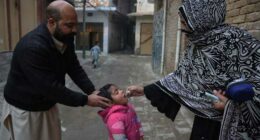Share this @internewscast.com
During his college years, Marshawn Kneeland was the focus of two welfare checks by Western Michigan police after he expressed suicidal thoughts, according to reports.
Kneeland, who passed away by suicide at the age of 24 this month, played five seasons with Western Michigan before the Dallas Cowboys drafted him in the second round of the 2024 NFL Draft.
ESPN reports that the former Cowboys player faced two welfare checks while at the university. Concerns were raised by his coaches, worried he might have a gun, following his disclosure of suicidal thoughts.
The university’s football coach, Lance Taylor, along with defensive coordinator Lou Esposito, reportedly contacted police in June 2023. They wanted to ensure Kneeland was mentally prepared to own a firearm, noting he had recently broken up with his girlfriend.
An officer’s report indicated that Kneeland willingly handed over his firearm to campus police for safekeeping until he was evaluated by a counselor.
Twelve days later, Kneeland retrieved his gun after a social worker from Western Michigan’s Sindecuse Health Center provided a letter stating he was not a danger to himself or others following an assessment.

Western Michigan police reportedly carried out two welfare checks on Marshawn Kneeland during his college days

Kneeland, pictured with his girlfriend Catalina Mancera, died this month in an apparent suicide
Three years earlier, one of Kneeland’s friends are believed to have called 911 to express concerns, before police found him near train tracks and he spoke of suicidal thoughts.
The officer who responded to the scene wrote in a report that he ‘told me he was sitting across the tracks in hopes a train would run him over to end his life.’
‘Kneeland told me life overall and the lack of playing football at WMU had him feeling down,’ the officer added in the report. ‘He told me he had been feeling like this for a while.
‘When asked to clarify how long he felt that way, he did not answer. Kneeland said he does not see a therapist or take any medication for his mental health crisis.’
Despite insisting he didn’t want medical help, Kent County sheriff’s deputies sent him to a hospital in Kalamazoo, Michigan.
‘WMU’s football program and our greater community are heartbroken by the loss of Marshawn,’ Western Michigan’s athletic department said in a statement to ESPN.
‘He was deeply loved and cared for here. Bronco Athletics provides holistic support for all our student-athletes including mental health services with professional counselors. Marshawn made use of those mental health resources during his time at WMU. The entire football staff was proud of Marshawn, who grew to become a captain and a leader in the program, and ultimately a graduate of Western Michigan University.’
Kneeland drove at nearly 150mph before crashing into another car on the night of his death, according to a police report obtained by TMZ.

The late Dallas Cowboys star is said to have revealed suicidal thoughts at Western Michigan
A Texas Department of Public Safety officer clocked him speeding at around 10:30pm on November 5. After following him, he then saw the late NFL player making ‘several unsafe lane changes’ as he passed other cars.
The officer claims he attempted to pull Kneeland over but he did not comply and, before long, the Dodge Charger disappeared out of view.
According to reports, police found the car minutes later. It had crashed into another vehicle before stopping in a field but Kneeland was not there.
Inside the car, police claim to have found an empty gun holster but no firearm. The authorities then launched a search for Kneeland – including using dogs.
His body was eventually found in a port-a-potty around 1.30am on November 6. He had reportedly suffered a fatal – and self-inflicted – gunshot wound.
The Cowboys star had earlier sent his family a group text saying ‘goodbye’ during the drama involving the Texas Department of Public Safety troopers, according to a police audio dispatch.
Kneeland’s girlfriend Catalina Mancera also warned the police that the NFL player had a gun and that she feared he would kill himself.
If you or someone you know is having thoughts of suicide, contact the Suicide & Crisis Lifeline at 988 or at http://988lifeline.org.



